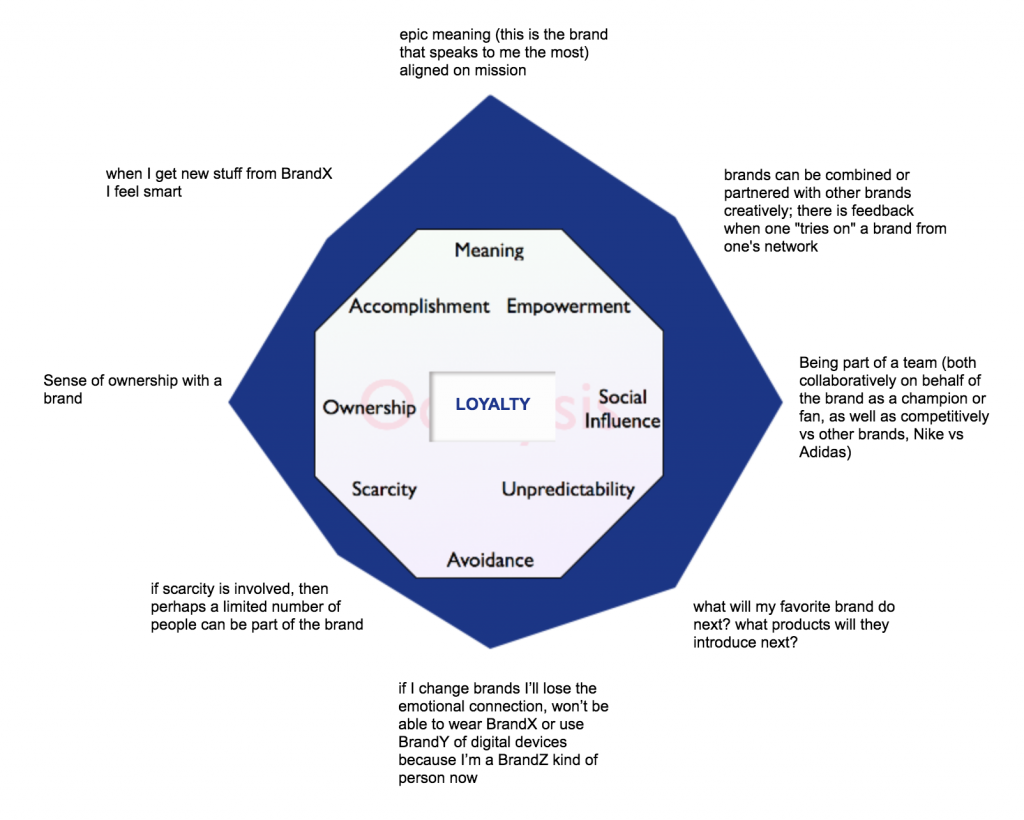Creating loyalty through marketing and customer relationships
Just like someone can’t have more than about five really close friendships, it is hard to have extreme loyalty toward more than a few brands. But if your brand is one of those to a customer, the lifetime value of that customer is extraordinary.
But designing for loyalty is very difficult. How do you know where to start?
Loyalty combines many of the 8 Core Drives, but probably starts with Core Drive 1: Epic Meaning & Calling.
Yu-kai shared with me that
The best brand loyalty comes from good CD1 design. People believe in its mission, purpose, or narrative.
In this article, we’ll explore how to create and maintain loyalty using Octalysis gamification. First, let’s look at this from an Octalysis perspective.
The Core Drive Analysis
Creating loyalty
For potential customers and new customers, the best way to design for loyalty is through a strong Core Drive 1 message. Note: this message could be non-Core-Drive-1. For example, Nike’s slogan is “just do it”, which is a Core Drive 2: Development & Accomplishment style of message. But someone who believes in springing to action will identify with this message from a Core Drive 1 motivation.
When entering a marketplace where there are strong incumbents, a powerful message can pull loyal fans from other brands. Consider Under Armour (https://www.underarmour.com). It entered the sports realm with an underdog message pulling athletes to its brand who blossomed into big names (think Steph Curry, who just landed the biggest contract in NBA history). Social identity theory and shared values have a part to play here. Some consumers want to have shared values with the brand, while others will be loyal regardless of values. Segmenting your customer base allows you to tailor messages to each group. Shared values can be understood from Core Drive 1: Epic Meaning & Calling (a higher value) in combination with Core Drive 5: Social Influence & Relatedness (connection to the brand itself) and Core Drive 4: Ownership & Possession (feeling strongly about a value to the extent that it matters above other buying behaviors in a decision tree).
Maintaining loyalty (not losing loyalty)
Communication is crucial to maintaining loyalty once established. Unless someone is loyal for life, loyalty can wane, diminish, and disappear. Designing the 4 phases of an experience is really important to build the correct habits into your core experience. How you create loyalty during Discovery and Onboarding transitions to maintenance during Scaffolding and the Endgame.
Tactics to maintain loyalty:
This is where email outreach, product quality, customer support, and personalization enter the loyalty equation. Balancing rewards and ensuring customers are treated fairly (by using customer tiers based on engagement) are important. If you have a Standard, Premium, and Pro customer base, the perception of those must match the experience (and the price).
Email outreach
Interactions build and strengthen relationships. How often and with what offering or value are you doing so? Frequency matters, but only to a degree. What matters is the quality and emotional takeaway for the recipient. Relationships involve many of the Core Drives, but revolve around Core Drive 5: Social Influence & Relatedness.
Product quality
Does your product actually solve a problem and stand out? Most people will probably discover your product (Discovery Phase of the 4 Phases) through Core Drive 7: Unpredictability & Curiosity.
Customer support
Do customers leave support calls/chats with a smile on their face? Train your support staff to provide the ultimate in Core Drive 5: Social Influence & Relatedness and creative problem solving, Core Drive 3: Empowerment of Creativity & Feedback.
Personalization
How are you going above and beyond to understand your user wants and needs? Whether you use a Customer Relationship Management (CRM) tool or a well-versed and caring support staff or a dedicated marketing team, giving users the personalization of Core Drive 4: Ownership & Possession will make them understand you get them and you have their needs foremost in mind.
Balancing rewards
In experiences where rewards are offered (or triggered) through an investment of time or effort by a user, ensuring that the reward feels right will create trust in the brand’s ability to deliver on the next user investment. Variable rewards can be useful here. A detailed look at your Strategy Dashboard is one place to start.
Customer Tiers
These are especially useful in subscription-based business models. These tiers not only inspire user action through Core Drive 2: Development & Accomplishment, but also serve as a light Core Drive 6: Scarcity & Impatience play as well.
Building better loyalty
At The Octalysis Group, we are regularly asked to built strong loyalty programs and we love the challenge of designing loyalty improvements into existing experiences.
Curious to know how we can help your organization create such long lasting engagement?
Contact Joris Beerda to get started:
joris@octalysisgroup.com





